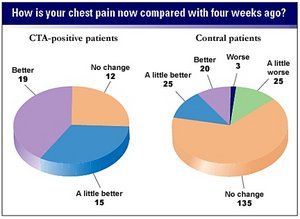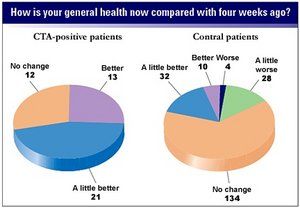Refund requests are an unavoidable part of running a chiropractic practice. Whether a patient is unhappy with their care, believes an adjustment caused harm, or simply changes their mind, these situations must be handled carefully to avoid escalation. While chiropractors are not legally obligated to issue refunds in most cases, there are times when doing so is the best business decision to protect the practice.
Chiropractic May Help Relieve Angina Pectoris
In what is believed to be the first study of its kind, researchers in Denmark have provided evidence that manual therapy performed by a doctor of chiropractic is effective in treating chest pain. The results of the study, which appear in a recent issue of the Journal of Manipulative and Physiological Therapeutics, indicate that patients with a specific type of angina pectoris may benefit from a four-week session of regular chiropractic care, although the authors of the study caution that further trials need to be conducted to verify their findings.
According to the American Heart Association, more than 6 million Americans have angina pectoris. While it may not cause long-term damage to the heart, it is considered a sign of heart disease, and indicates that a person is at increased risk of suffering a heart attack or cardiac arrest. Of the different types of angina pectoris, one of the most common is stable (or chronic) angina, which occurs with some level of regularity and may be caused by physical exertion or different kinds of stress.
In the study, researchers recruited 275 patients with known or suspected stable angina. Fifty subjects diagnosed as having cervicothoracic angina (CTA), or chest pain originating from the cervical spine and thorax, upon examination comprised the treatment group. The remaining patients comprised the control group.
All of the CTA patients received eight sessions of "manual therapy" over four weeks, with treatment delivered by the same chiropractor. Each patient received at least one manual thrust each session, with high-velocity, low-amplitude (HVLA) force directed at one or more restricted cervical and/or thoracic joint segments. Trigger-point therapy was applied next, with manual pressure and deep stroking massage delivered to trigger points determined by the treating chiropractor. Patients who did not test positive for CTA were informed about their diagnosis by the chiropractor, but were offered no therapy.

On the day they were added to the study, and again at a follow-up visit after the last treatment session, all patients answered two sets of questionnaires. One set recorded the intensity of each patient's present chest pain, along with levels of shoulder, arm and spine pain experienced during the previous two weeks. The other questionnaire measured each patient's physical and mental state to assess his or her overall quality of life. In addition, during the follow-up visit, patients were asked whether their chest pain and general health had become "worse or a little worse," "unchanged," "a little better" or "better." Patients who had received manual therapy also were asked whether they thought the therapy had helped or not.

Results
More than 70 percent of the CTA-positive patients reported improvements in chest pain and general health after receiving manual therapy; only 26 percent reported no change, and no patients reported feeling worse at the end of treatment. In comparison, 13.5 percent of patients in the control group reported worse chest pain at follow-up, and 15.4 percent reported a decline in general health. When asked directly, 96 percent of the CTA-positive patients thought that chiropractic treatment had been beneficial.
Analysis of the pain questionnaires revealed that patients in both groups experienced a mean decrease in pain at the end of the study period. However, the decrease in pain was "significantly larger in CTA-positive patients," especially in the areas of maximum chest pain and average chest pain experienced during the last two weeks.
The results of the quality-of-life questionnaires provided perhaps the most revealing evidence of the benefits of chiropractic care. Among control patients, there was "virtually no change in mean scores" between baseline and the follow-up exam. In the CTA-positive patients, however, improvements were noted in all of the categories measured on the questionnaire, including statistically significant improvements in mental health, vitality, and emotional and physical measurements.
Limitations, Implications and Recommendations
Because the study was restricted to only patients with a specific type of angina pectoris, the authors were unable to determine whether chiropractic could be effective in treating other types of chest pain. Other limitations included the fact that the control group had both a different condition and a different treatment protocol, "which may have caused some confounding" as a result.
Consequently, the authors cautioned that their study "should merely be regarded as a first attempt to approach the question if manual therapy may benefit some patients with chest pain normally considered to be a type of angina pectoris." In their conclusion, they stated that "properly carried out randomized controlled trials must be carried out to make firm conclusions."
The results of this study are encouraging; however, at this point, they should not be interpreted to mean that manual therapy is an effective alternative to traditional medical care in the treatment of chest pain, whether stable angina, unstable angina or variant angina (also known as Prinzmetal's angina). People with new, worsening or persistent chest pain and discomfort should be examined in a hospital emergency department for a complete evaluation. The American Heart Association also offers tips to reduce the incidence of angina and improve overall heart health. Regardless of whether these study findings stand the weight of additional research, the following should be standard advice to every chiropractic patient:
- Stop smoking and avoid secondhand tobacco smoke.
- Eat healthy meals that are low in saturated fat, cholesterol and salt.
- Control high blood pressure and blood cholesterol levels.
- Avoid extreme temperatures.
- Avoid strenuous activities.
- Learn to relax and manage stress.
- Contact a doctor if your angina changes (for example, if you suffer angina while resting or if the condition worsens).
References
- Christensen HW, Vach W, Gichangi A, et al. Manual therapy for patients with stable angina pectoris: a nonrandomized open prospective trial. Journal of Manipulative and Physiological Therapeutics November 2005;28(11):654-661.
- What Is Angina? American Heart Association stat sheet, 2004. Available online at www.americanheart.org.
Written by Michael Devitt



